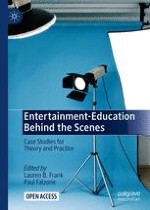
Open Access 2021 | OriginalPaper | Buchkapitel
21. Epilogue: The Next Reel for Entertainment-Education
verfasst von : Paul Falzone, Lauren B. Frank
Erschienen in: Entertainment-Education Behind the Scenes
Verlag: Springer International Publishing
Aktivieren Sie unsere intelligente Suche, um passende Fachinhalte oder Patente zu finden.
Wählen Sie Textabschnitte aus um mit Künstlicher Intelligenz passenden Patente zu finden. powered by
Markieren Sie Textabschnitte, um KI-gestützt weitere passende Inhalte zu finden. powered by